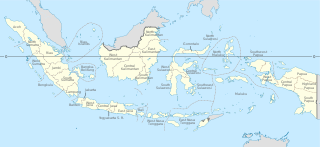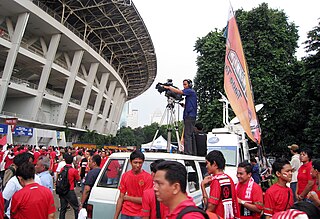
Provinces are the first-level administrative divisions of Indonesia. It is formerly called the first-level provincial region before the Reform era. Provinces have a local government, consisting of a governor and a regional legislative body. The governor and members of local representative bodies are elected by popular vote for five-year terms, but governors can only serve for two terms. Provincial governments have the authority to regulate and manage their own government affairs, subject to the limits of the central government.
A regency, sometimes incorrectly referred to as a district, is an administrative division of Indonesia, directly under a province and on the same level with city (kota). Regencies are divided into districts.
Indonesia is divided into provinces. Provinces are made up of regencies and cities (kota). Provinces, regencies, and cities have their own local governments and parliamentary bodies.

TVRI, legally Lembaga Penyiaran Publik (LPP) Televisi Republik Indonesia is an Indonesian national public television network. Established on 24 August 1962, it is the oldest television network in the country. Its national headquarters is in Gelora, Central Jakarta.
In Indonesia, village or subdistrict is the fourth-level subdivision and the smallest administrative division of Indonesia below a district, regency/city, and province. Similar administrative divisions outside of Indonesia include barangays in the Philippines, Muban in Thailand, civil townships and incorporated municipalities in the United States and Canada, communes in France and Vietnam, dehestan in Iran, hromada in Ukraine, Gemeinden in Germany, comuni in Italy, or municipios in Spain. The UK equivalent are civil parishes in England and communities in Wales. There are a number of names and types for villages in Indonesia, with desa being the most frequently used for regencies, and kelurahan for cities or for those communities within regencies which have town characteristics. According to the 2019 report by the Ministry of Home Affairs, there are 8,488 urban villages and 74,953 rural villages in Indonesia. North Aceh Regency contained the highest number of rural villages (852) amongst all of the regencies of Indonesia, followed by Pidie Regency with 730 rural villages and Bireuen Regency with 609 rural villages. Prabumulih, with only 12 rural villages, contained the fewest. Counted together, the sixteen regencies of Indonesia containing the most rural villages—namely, North Aceh (852), Pidie (730), Bireuen (609), Aceh Besar (604), Tolikara (541), East Aceh (513), Yahukimo (510), Purworejo (469), Lamongan (462), South Nias (459), Kebumen (449), Garut (421), Bojonegoro (419), Bogor (416), Cirebon (412), and Pati (401)—contain one-third of all the rural villages in Indonesia. Five of these are located in Aceh, two in Highland Papua, three in Central Java, two in East Java, three in West Java, and one in North Sumatra. An average number of rural villages in the regencies and 15 cities of Indonesia is 172 villages. A village is the lowest administrative division in Indonesia, and it is the lowest of the four levels. A village is usually divided into a number of hamlets, and there are 252,315 hamlets in Indonesia.

Radio Republik Indonesia, legally Lembaga Penyiaran Publik (LPP) Radio Republik Indonesia, is a public radio network of Indonesia. Founded on 11 September 1945, it is the first radio network in Indonesia and the second oldest media company in the country after Antara. RRI headquarters are located on Medan Merdeka Barat Street in Central Jakarta, Jakarta.

The mass media in Indonesia consist of several different types of communications media: television, radio, cinema, newspapers, magazines, and Internet-based websites.

An Indonesian passport is a travel document issued by the Government of Indonesia to Indonesian citizens residing in Indonesia or overseas. The main governing body with regards to the issuance of such passport(s), possession(s), withdrawal and related matters is the Directorate General of Immigration under the Ministry of Law and Human Rights. Indonesia does not recognize multiple citizenship for its citizens and such citizens will automatically lose their Indonesian citizenship if another citizenship is acquired voluntarily. Special exceptions allow newly born citizens to hold dual nationalities until his/her eighteenth birthday after which a choice of either nationalities should be decided. The latest Indonesian passport has different national birds and sceneries on each page.
Law of Indonesia is based on a civil law system, intermixed with local customary law and Dutch law. Before the Dutch presence and colonization began in the sixteenth century, indigenous kingdoms ruled the archipelago independently with their own custom laws, known as adat. Foreign influences from India, China and the Middle East have not only affected culture, but also the customary adat laws. The people of Aceh in Sumatra, for instance, observe their own sharia law, while ethnic groups like the Toraja in Sulawesi still follow their animistic customary law.

Television in Indonesia started in 1962, when the then state-run station TVRI began broadcasting – the third country in Southeast Asia to do so. TVRI held a television monopoly in Indonesia until 1989 when the first commercial station, RCTI began as a local station and was subsequently granted a national license a year later. The Indonesian television is regulated by both Ministry of Communications and Informatics (Kemenkominfo) for frequency matters and Indonesian Broadcasting Commission (KPI) for content matters.

Digital terrestrial television in Indonesia (DVB-T2) started in 2009, and in most areas runs alongside the analogue TV system. The first phase of nationwide analog shutdown was done in 166 regencies and cities, including Dumai, Banda Aceh, Batam, Tanjungpinang, Serang, Bali, Samarinda, Tanjung Selor, Tarakan, Makassar and Jayapura, starting on 30 April 2022 and it simplified in three stages. An analog broadcasting station in Jakarta along with 173 regencies/cities non-terrestrial services was officially signed off on 2 November 2022 at midnight. Batam, Bandung, Semarang, Surakarta and Yogyakarta followed on 2 December 2022, Surabaya on 20 December 2022, Banjarmasin on 20 March 2023, Bali and Palembang on 31 March 2023, Makassar on 20 June 2023 and Medan on 30 July 2023. On 15 July 2023, at midnight, Trans Media and Emtek/SCM officially completed the shutdown. On 31 July 2023, at midnight, Viva Group, RTV, and NET TV officially completed the shutdown of analog broadcast nationwide, followed by MNC Group on 1 August 2023 at midnight. On 12 August 2023, the digital terrestrial television of Indonesia fully turned, shifted and switched to all high definition on all thirteen local free-to-air terrestrial television station.
In Indonesia, state-owned enterprises play an important role in the national economy. Their roles includes contributor for national economy growth, providing goods or services which are not covered by private company, employment provider, providing support guidance to small and medium businesses, and source of government revenue. The Ministry of State Owned Enterprises represents the government's function as a shareholder of most of those companies, while some are represented by the Ministry of Finance.
In Indonesian law, the term "city" is generally defined as the second-level administrative subdivision of the Republic of Indonesia, an equivalent to regency. The difference between a city and a regency is that a city has non-agricultural economic activities and a dense urban population, while a regency comprises predominantly rural areas and is larger in area than a city. However, Indonesia historically had several classifications of cities.
TVRI World is an Indonesian television channel owned by public broadcaster TVRI, catered for domestic and international audience. The English-language channel is currently on its trial broadcast, with its planned launching in 2024. The channel is domestically available in digital terrestrial, satellite, and TVRI Klik streaming service.

TVRI Sumatera Utara is a regional public television station owned-and-operated by TVRI, serving North Sumatra, Indonesia. TVRI Sumatera Utara studios are located in Medan, and its main transmitter is located in Bandar Baru, Sibolangit, Deli Serdang.

National Resilience Institute is an Indonesian Non-Ministerial Government Agency tasked with carrying out government duties in the field of education for national leaders, strategic assessment of national resilience and strengthening of national values.
Non-ministerial government body, was known as Non-departmental government body, is Indonesian state body for specific government task from the President. Chief of LPNK is directly responsible to the President or relevant minister.

PT Jaminan Kredit Indonesia (Jamkrindo) is a part of one of Indonesia's state-owned enterprises and is a component of PT Bahana Pembinaan Usaha Indonesia, operating in the field of credit guarantee, both conventional and sharia. It is the only state-owned enterprise tasked with providing guarantees.












